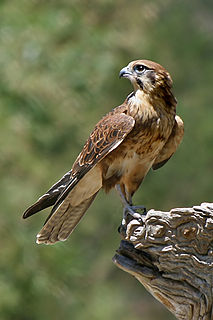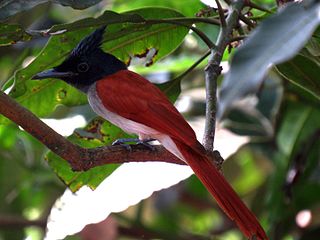
Organisms of many species are specialized into male and female varieties, each known as a sex. Sexual reproduction involves the combining and mixing of genetic traits: specialized cells known as gametes combine to form offspring that inherit traits from each parent. The gametes produced by an organism define its sex: males produce small gametes while females produce large gametes. Individual organisms which produce both male and female gametes are termed hermaphroditic. Gametes can be identical in form and function, but, in many cases, an asymmetry has evolved such that two different types of gametes (heterogametes) exist.

Falcons are birds of prey in the genus Falco, which includes about 40 species. Falcons are widely distributed on all continents of the world except Antarctica, though closely related raptors did occur there in the Eocene.

Carp are various species of oily freshwater fish from the family Cyprinidae, a very large group of fish native to Europe and Asia. While carp is consumed in many parts of the world, they are generally considered an invasive species in parts of Africa, Australia and most of the United States.

In biological classification, the term subspecies refers to one of two or more populations of a species living in different subdivisions of the species' range and varying from one another by morphological characteristics. A single subspecies cannot be recognized independently: a species is either recognized as having no subspecies at all or at least two, including any that are extinct. The term may be abbreviated to subsp. or ssp. The plural is the same as the singular: subspecies.

Coronaviruses are a group of related RNA viruses that cause diseases in mammals and birds. In humans and birds, they cause respiratory tract infections that can range from mild to lethal. Mild illnesses in humans include some cases of the common cold, while more lethal varieties can cause SARS, MERS, and COVID-19. In cows and pigs they cause diarrhea, while in mice they cause hepatitis and encephalomyelitis.

Vulpes is a genus of the sub-family Caninae. The members of this genus are colloquially referred to as true foxes, meaning they form a proper clade. The word "fox" occurs on the common names of species. True foxes are distinguished from members of the genus Canis, such as domesticated dogs, wolves, jackals and coyotes, by their smaller size (5–11 kg), longer, bushier tail, and flatter skull. They have black, triangular markings between their eyes and nose, and the tip of their tail is often a different color from the rest of their pelt. The typical lifespan for this genus is between two and four years, but can reach up to a decade.

Monitor lizards are large lizards in the genus Varanus. They are native to Africa, Asia, and Oceania, but are now found also in the Americas as an invasive species. About 80 species are recognized.
In biology, a monotypic taxon is a taxonomic group (taxon) that contains only one immediately subordinate taxon.

Coronaviridae is a family of enveloped, positive-strand RNA viruses which infect amphibians, birds, and mammals. The group includes the subfamilies Letovirinae and Orthocoronavirinae; the members of the latter are known as coronaviruses.

The red fox is the largest of the true foxes and one of the most widely distributed members of the order Carnivora, being present across the entire Northern Hemisphere including most of North America, Europe and Asia, plus parts of North Africa. It is listed as least concern by the IUCN. Its range has increased alongside human expansion, having been introduced to Australia, where it is considered harmful to native mammals and bird populations. Due to its presence in Australia, it is included on the list of the "world's 100 worst invasive species".

Chamaemyia elegans is a species of fly in the family Chamaemyiidae. It is present in Europe, including mainland France.
Chamaemyia flavipalpis is a species of fly in the family Chamaemyiidae. It is found in the Palearctic.
Chamaemyia nigripalpis is a species of fly in the family Chamaemyiidae. It is found in the Palearctic.
Chamaemyia paludosa is a species of fly in the family Chamaemyiidae. It is found in the Palearctic.
Chamaemyia sylvatica is a species of fly in the family Chamaemyiidae. It is found in the Palearctic.
Chamaemyia bicolor is a species of fly in the family Chamaemyiidae. It is found in the Palearctic.
Chamaemyia flavoantennata is a species of fly in the family Chamaemyiidae. It is found in the Palearctic.
Chamaemyia submontana is a species of fly in the family Chamaemyiidae. It is found in the Palearctic.
Chamaemyia hungarica is a species of fly in the family Chamaemyiidae. It is only found in Hungary.









